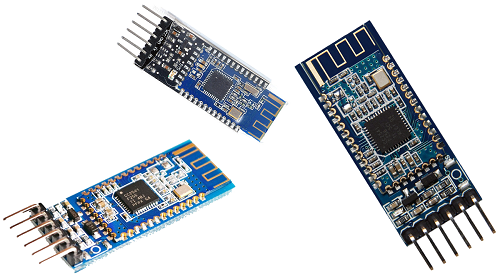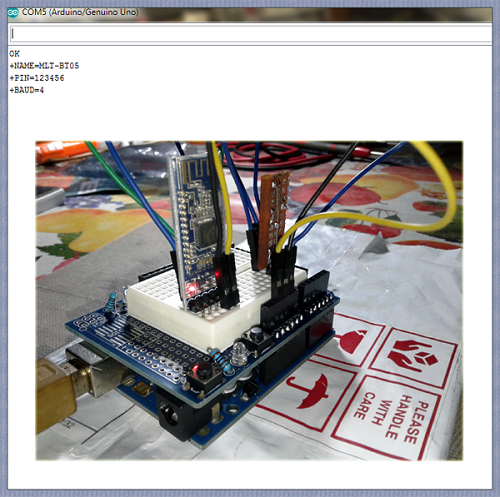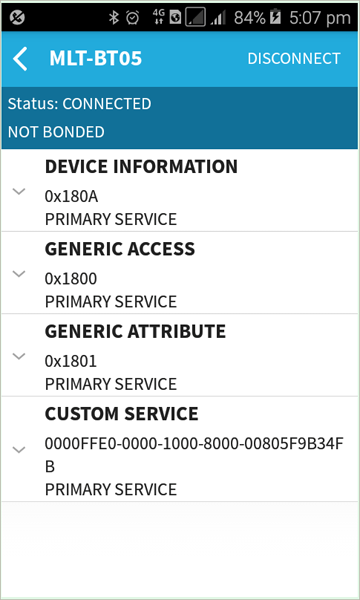By T.K. Hareendran, contributing writer
I recently got a hold of some cheap Bluetooth modules from eBay to build a project with Bluetooth Low Energy (BLE) communication. The eBay seller’s listing used the name “HM-10 BLE Bluetooth 4.0” for the module, which is a far-famed Arduino-compatible BLE module with UART serial communication interface. A few days after my order, I got the packet, but I quickly discovered that the modules I received seemed like dirt-cheap clones of the real HM-10 BLE module, which was developed and is supported by Jinan Huamao Technology. (Oh well; if I don’t have a little chaos in my life, I feel lost!)

HM-10 BLE Bluetooth 4.0
The HM-10 is a tiny 3.3-V BLE Bluetooth 4.0 module based on the TI CC2540/CC2541 Bluetooth SoC. It can be controlled via AT commands, which are sent over the serial UART connection. Most of the latest HM-10 modules, though, are based on the CC2541 chip, with lower power and a shorter range than the former CC2540 version. Take note: HM-10 is a BLE Bluetooth 4.0 module, which means that it cannot connect to Bluetooth 2/2.1 modules like the good old HC-05 and HC-06. This is because BLE is not an upgrade to Bluetooth Classic; it works in a very different way.
The HM-10 offers only edge connections, so it usually comes mounted on a breakout board that extends requisite connections to breadboard-friendly male-header pins (which is how mine came from eBay). The six-pin breakout board also typically includes an onboard LDO voltage regulator (3.3 V) that makes the module compatible with a 5-V power rail. A good example of one such 5-V-compatible module is the somewhat-expensive “Keyes HM-10” module with on-board voltage regulator and logic level translator. Sadly, most of the other cheap “HM-10 eBay modules” do not have these inbuilt logic level translators; thus, the UART remains at a 3.3-V level, which makes them mismatched to the UART of common 5-V microcontrollers. This mismatch calls for an external logic level translator/shifter circuitry.

The HM-10 module, shown here in blue, is usually delivered mounted to a breakout board containing IO pins and level translator circuits.
Clones and clones
After lots of crawling about on the web, I finally found that the modules I got were actually clones of the CC41-A, named as MLT-BT05, which is itself another distant clone of the HM-10. The “clone of the clone” is different in hardware and in firmware to some extent. Although the hardware looks identical, there’s no second crystal (see the empty solder pads). Furthermore, the three-pin voltage regulator chip seems like a different type.

Fortunately, both the HM-10 and CC41 use AT commands over the serial connection to configure the module. When the module is connected to another BLE device, the serial connection can be used for sending and receiving data (data mode), and when the module is disconnected from another BLE device, the serial connection is for sending and receiving commands (command mode). A single serial interface can be used for both data and commands.
However, the HM-10 AT commands are different from CC41 AT commands. For example, end-of-line termination with HM-10 expects no new-line (NL) or carriage-return (CR), while the CC41 demands both. The MLT-BT05 also follows the CC41’s AT commands style, but with some minor divergences.
Initial validation
I’d used both my Arduino board and Android phone to validate the connectivity. For the first test, I used an Arduino Uno to ensure that my HM-10 clone can work with Arduino platform without apparent issues. Once I had the hardware up and running, I uploaded a test code, switched on the Serial Monitor (9600 baud, NL and CR selected), and typed some AT commands. Happily, I received prompt answers from the clone. Furthermore, the BLE module showed that it will work autonomously without the need of a costly microcontroller. More on this idea in a future post.

The second test took place using an Android phone with the free app “BLE Scanner” (by Bluepixel Technology LLP) downloaded from Google Play store (see the screenshot). For that tryout, I just powered up the BLE module from a 5-V breadboard power supply. The onboard LED (system LED @P101), was useful to be able to see whether the module is powered and whether it is connected. This LED will flash when turned on and stay on if it is connected to a BLE device.

In my view, Bluetooth Low Energy is an empowering technology. If you plan to prototype an affordable electronic device that features low-power wireless networking, then there is no smarter solution than BLE. You can start with trialing a less complex and cheaper BLE module (preferably on the breakout board), such as the HM-10. That could be all you need, assuming that the likelihood of using clones doesn’t nettle you. If you do have a clone, then, you will find it crucial to ensure that it has the functionality that you are looking for. In the meantime, Huamao has now released newer versions of the HM10 as well as the HM11 — the limited edition of HM10 with enhancements that include compatibility up to Bluetooth 4.2 and 5-V tolerance.
More hands-on reviews by T. K.:
Hands-on review: When hacking an OBD-II adapter, choose carefully
Hands-on review: ESP32 offers a powerful IoT-enabled MCU for novices and pros alike
Hands-on review: getting started with the Intel tinyTILE
Hands-on review: Open-source MinnowBoard Turbot SBC is fast, powerful, and versatile
Hands-on review: Analyze signals with free, open-source sigrok PulseView
Advertisement
Learn more about Electronic Products Magazine





